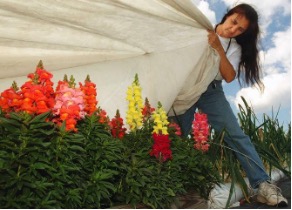For pets, do not leave your animals outside for a long period of time, even if they typically live outdoors. Treat your pets how you would like to be treated. If you are cold, they are cold. If you must leave pets outdoors, reinforce their shelter with straw or blankets.
 Plants: Cover what you can with cloth, burlap, or frost cloth. Avoid using plastic on plant material. Covers are helpful in protection from frost more so than cold temperatures. Covers need to be extended to ground to trap radiant heat and may need to be anchored down with, rocks, soil; anything to keep from blowing off. Gallon milk or water jugs can be used to protect smaller plants. Cut the flat bottom off and place the jugs over the plants. Adding light bulb nearby or Christmas lights under cover is easy way of providing heat temporarily. Remove them on sunny days, so not to burn. Adding mulch around plants to protect roots is helpful. Some perennials will die back naturally in winter, the root system is all that needs to be protected. New foliage will generate in spring.
Plants: Cover what you can with cloth, burlap, or frost cloth. Avoid using plastic on plant material. Covers are helpful in protection from frost more so than cold temperatures. Covers need to be extended to ground to trap radiant heat and may need to be anchored down with, rocks, soil; anything to keep from blowing off. Gallon milk or water jugs can be used to protect smaller plants. Cut the flat bottom off and place the jugs over the plants. Adding light bulb nearby or Christmas lights under cover is easy way of providing heat temporarily. Remove them on sunny days, so not to burn. Adding mulch around plants to protect roots is helpful. Some perennials will die back naturally in winter, the root system is all that needs to be protected. New foliage will generate in spring.
Grafted or budded plants such as gardenias and fruit trees can be protected by insulating the trunks with tree wrap or mounds of soil around the graft union. Be sure to remove the wrap or soil by mid-March. For tips on preparing for cold weather, go to UF/IFAS EDIS document https://edis.ifas.ufl.edu/publication/FY1407
After freeze, do not cut anything back as it encourages new growth. We don’t want new cells trying to push out buds or leaves until spring. Check for water needs. A windy event may have plants working overtime, transpiring. Check for dead tissue by scraping lightly on the stem or trunk with fingernail. If you see green (cambium
layer) it’s alive, brown, or black indicates dead tissue. Mid-March is when we can start pruning back.
Learn more about North Florida cold protection of landscape plants at https://edis.ifas.ufl.edu/publication/MG025 or contact UF/IFAS Taylor County Extension office at 850-838-3508.
 3
3
